SEO strategies shift in importance all the time, it’s the nature of our industry. Some strategies gain importance while others that we’ve grown accustomed to over the years lose their ability to drive search visibility.
How users search and interact with SERPs evolves, too. Google isn’t idle either, constantly testing updates and introducing new elements to SERPs to better satisfy users' needs.
In fact, in a recent study across millions of queries, we found over 800 unique features in the SERPs. This isn’t Matt Cutts’ Google anymore… Mobile is growing quickly as well, just consider the rich snippets.
I admit that such a pace of development may seem intimidating. I can imagine you often wondering about what you should be focusing on next to meet your goals, or what your competitors are doing that you may be late to the party for.
As part of my work as the VP of Client Success here at seoClarity, I’ve traveled all over the world, talking to SEOs, learning about their challenges, and exchanging experiences. I’ve visited more than 50 global brands this year alone, and this is what I see the top sites prioritizing next. These are focused on real-world, practical applications to scale SEO to drive visibility, organic traffic, and revenue.
Page Speed (and Usability in General) Matters More and More
Always consider the search experience. You want to drive sticky traffic where people are staying on your page, and improve the areas that have a high bounce rate and are not sticky but should be.
One way to ensure a minimal bounce rate is to optimize site usability.
Technical SEO has always been critical to succeeding in developing strong search visibility.
But as you most likely know already, technical problems not only affect the code or server applications, but the user experience and site usability as well.
Users who find a site cumbersome to use, struggle to find the information they need, or even can’t navigate through it easily will leave to try another search result, sending poor engagement signals to Google in the process.
If you are not focusing on usability, the other SEO strategies you implement won’t even matter.
One technical SEO factor that is particularly prominent is page speed and its effect on usability and SEO.
This should come as no surprise, really. No customer will wait for a webpage to load, after all. Most of them will turn to find one that works better and faster.
In fact, Google shares research from SOASTA citing that a one-second delay in mobile load time can create a 20% change in conversion rate.
So, the first practical SEO strategy to focus on in 2020 is the page load time.
Here are some ideas to help you make it happen:
Score your site with Google. Understand what factors impact how fast your page loads, from Google's perspective, of course.
Google’s report outlines them quite well, suggesting the areas for improvement. They also introduced the mobile Speed Scorecard and Impact calculator in early 2018 to illustrate how performance can affect your revenue.
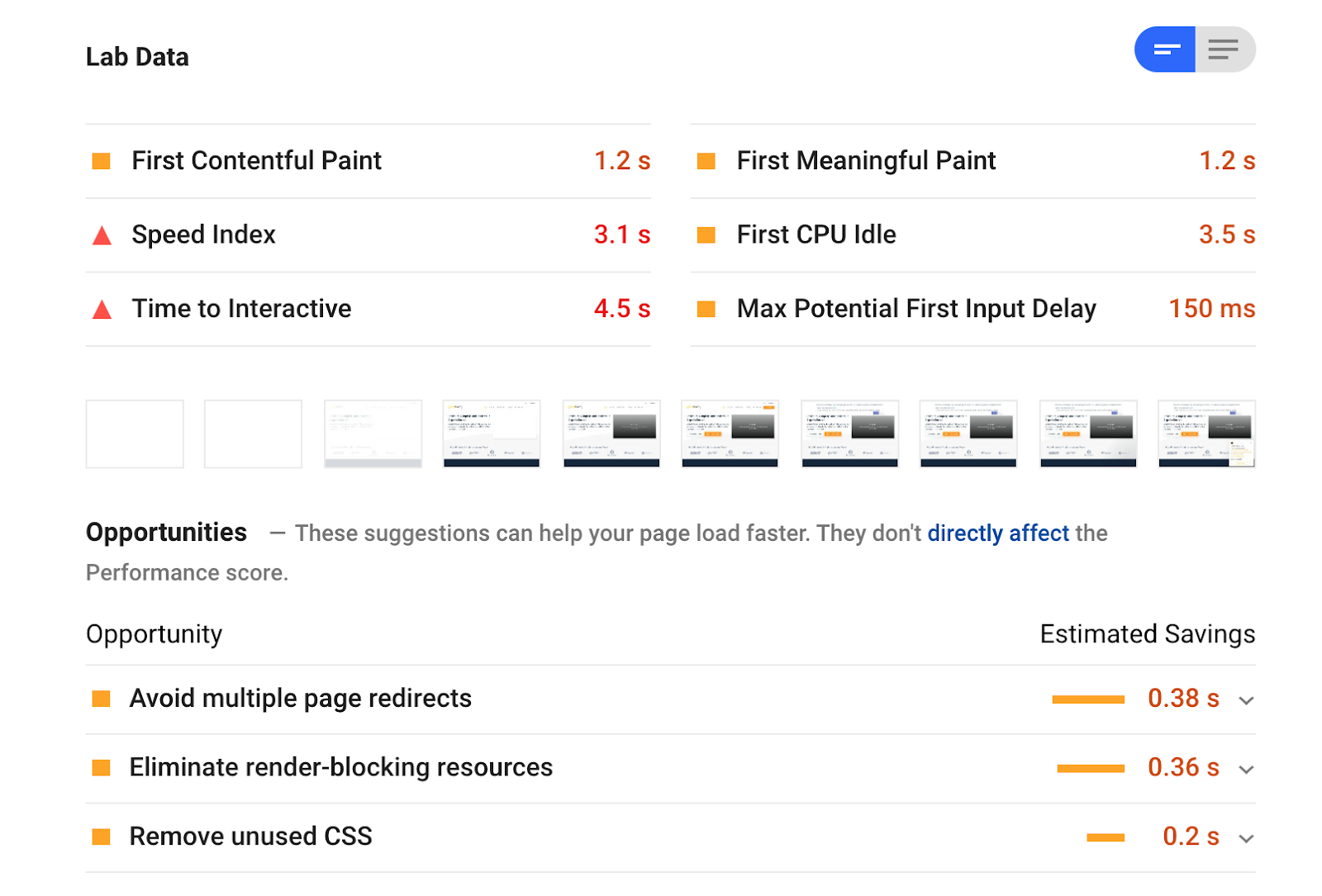
(Google's page speed test report.)
Leverage Clarity Audits. Our site audit technology includes a dedicated report on Page Speed insights that allows you to dive incredibly deep into your site’s performance.

(One of Clarity Audit’s Page Speed dashboard reports.)
Paying attention to the time of first byte and what fully loading looks like on your site will help you identify areas that are running slower, and understand why they are slower.
Another area of concern would be the third-party tools running on the site. Their outdated versions, incorrect implementation, or perhaps just bad tools might be the reason for slower page performance.
Review server log files for bot activity, too. The unfortunate thing is that you might have pages that are under constant bot attacks, which is also going to slow them down. Or, if Google is spending too much of your crawl budget on pages of your site you don’t want it to, then you should know about it.
I’m not finished yet, here are a couple other tips from a few big global companies:
- Identifying potential page-load bottlenecks may help uncover potential security risks on your site.
- It could also help you understand what factors make your pages load incredibly fast. For example, super fast loading may mean there’s just HTML on the page and there’s something drastically wrong.
Recommended reading: Your Quick Guide to Page Speed Success
Internal Link Analysis
All sites have at least some flaws with their internal linking. It’s to be expected, actually. When you manage a site with tens of thousands of pages and are constantly growing, it’s easy to lose track of how you’re interlinking various assets.
But, it’s also important that you have as little chaos within your internal link structure as possible.
Building the right authority between pages is critical, and is something you can control with internal linking.
Interlinks also help Google understand the content of your most important pages, their relationship, the structure of the site, and help to ensure that all the critical content gets crawled and indexed.
So, even though you will always have some problems with the internal linking structure, develop workflows to implement them correctly on strategic pages.
How can you improve internal links? Leverage the Internal Link Analysis within seoClarity’s site audit technology. It allows you to think more strategically about your internal link structure. Not only can you identify the links you have, but you can also analyze the internal link structure of every page on the site and evaluate what anchor text are you using when interlinking it with other assets. Such analysis will also uncover any potential redirect chains within internal links, and how your structure supports the user experience overall.
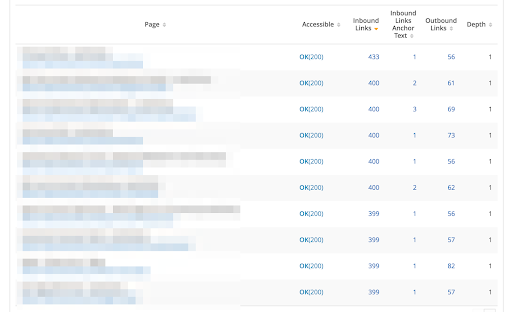
(Internal links report in Clarity Audits)
Building an Organic Sales Funnel and Keyword Intent
As SEOs, we’re often so extremely focused on conversions that we forget to engage with those people who aren’t aware of our brand, or perhaps a product and/or service we sell.
This important audience falls into the same critical marketing funnel that exists both online and offline. As marketers, it’s critical to build an organic approach to all buying stages to include awareness, transaction, and loyalty.
The funnel gives you the opportunity to:
- Introduce your brand to new customers when they’re in the early stages of the buying journey,
- Convert them into an email list, build a relationship with them, and nurture them to purchase, and
- Develop loyalty that will pay off with repeat purchases and referrals.
Enter Keyword Intent
At seoClarity, we often hear clients considering keyword intent as the “next thing,” and they put a lesser priority on introducing a content strategy for it.
Those companies who we see as leaders in their space for SEO, however, have been prioritizing keyword intent for years.
Focusing on user intent is a must. If you’re not doing this, you’re missing out on an opportunity to gain significant search visibility.
Why is keyword intent critical to SEO today?
First, it enables you to create content that matches customers’ expectations, depending on the stage of the buying cycle their search is at.
For example, if you’re an ecommerce website and have the category page “Christmas Gifts for Mom,” you should take a look at the SERP for this keyword. The majority of the results on page one are content sites, which means that Google thinks this query has informational intent. If you want to rank for this query, you need informational content, as your ecommerce category page is never going to rank.
SEO teams often have limited flexibility with writing or editing content. Or that they have exhausted all possible ideas for content on their site. But at a closer inspection, it’s evident that they haven’t focused on the early stages of the buying journey.
Also, take an example of a storage rental company. It’s easy for such a business to run out of ideas to engage users with content. In reality, though, they need to think outside of the box about the origins of where their customers’ needs begin, prompting a decision to search for their services.
For XYZ Storage Company, they could consider those people who have a sudden need to move cross-country into a different climate, perhaps. LA to Chicago is a drastic change in winter weather, why not build an entire content piece around heated storage spaces and other precautions to take?
There are ways that you can be thinking about the type of people you want to get your brand in front of, and build good quality, organic content to introduce your brand at the top of the search funnel.
And as our chief architect and co-founder Mitul Gandhi says: keep in mind the features of Google Discover – this is the way Google beats Facebook. Mitul's quote below highlights the importance of Discover well:
By automatically surfacing articles related to 'topics' in your search history, Discover is a gold mine for getting in front of people that may not have found you via rankings alone.
Build a deeper understanding of the searches your customers do before they search for your target terms. Focus on writing the content around those key topics that address their needs in the buying journey (and make sure it’s setup to be indexed and included). Google is trying to move users into the sales funnel, so always be aware of searcher intent.
Schema
Another priority the SEO leaders have discussed is their growing emphasis on implementing schema markup. And doing it well!
The product schema was introduced a few years ago to improve CTR, and a large majority of ecommerce sites implemented this markup. Now, as Google evolves and develops new schema options, more companies are implementing them. Take the FAQ panel that’s starting to appear in SERPs now.
.jpg?width=574&name=Slideshow%20(3).jpg)
(Google search results with star schema and FAQ.)
It’s amazing, and from what our data shows, it’s slowly being rolled out across industries.
HOT TIP: Because many industries are slow to implement FAQ schema, being an early adopter gives you the competitive advantage of testing and getting it right early. Then, when your competition starts to figure it out, you have already optimized your FAQ content and most likely have it driving clicks for you.
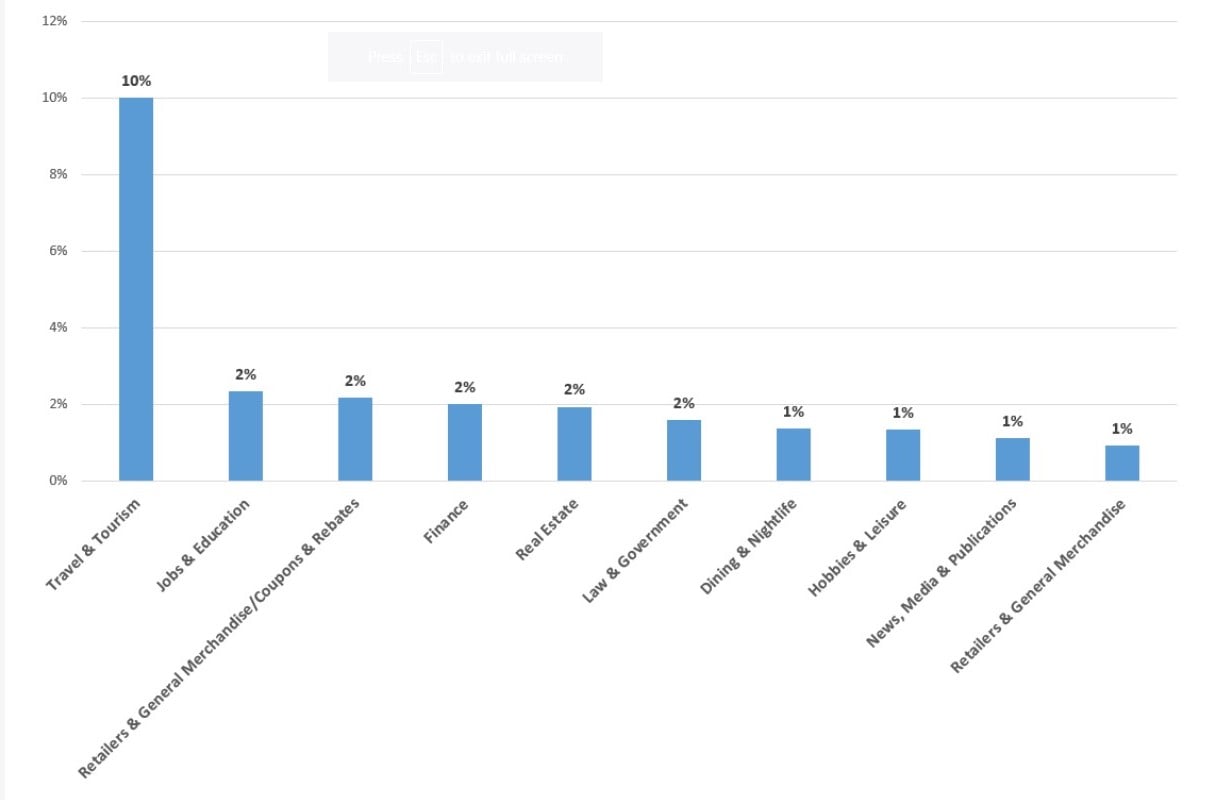 (Page one URLs with FAQ schema.)
(Page one URLs with FAQ schema.)
The markup attracts immediate attention to the search listing. Referring to the image of the SERP above, it’s the third result that features the FAQ markup, yet you see it first.
KAYAK is one example of a company doing this particularly well. They seem to have figured out how to use FAQ creatively, and engage customers by answering the very questions those people might have when on the site (e.g. "How does KAYAK find such low hotel prices?").
Look at these FAQs from the company’s hotels page:
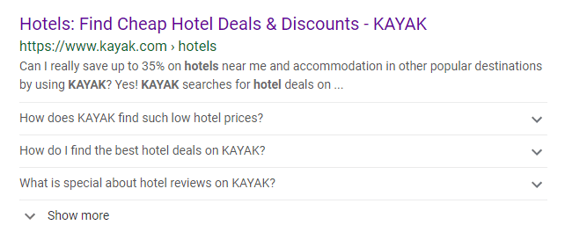
(KAYAK's FAQ results for a search query.)
Schema markup has the power to attract more attention to a search listing, regardless of its ranking. So, for a brand that has a lot of high performing keywords and strong search visibility but low click-through rate, adding schema can be a way to turn things around.
It’s because of this we say that a rank is no longer a rank – or at least rankings aren’t the same as how we’ve seen them in the past. Since organic listings can now include visualizations (i.e. schema), the listings that provide a good visual experience will earn clicks, even if they’re located further down the page.
Typically, we’ve considered rankings by the site’s position on the page and often apply a CTR that declines by position. Unfortunately, the first result isn’t necessarily at the top of the SERPs. Local pack, image carousel, PLAs, featured snippets, and many other search features can take precedence, pushing organic listings below the fold.
As a result, ranking in position one might not necessarily translate into the highest visibility.
Measuring the visibility rank gives brands the true idea of their actual presence and visibility in the SERP.
seoClarity offers a solution, Visibility Rank, that analyzes your Google keyword rank based on pixel height to understand how CTR truly affects your top positions in the SERPs.
Recommended Reading: Reef Digital Agency: What is the most important element of SEO for 2020?
Featured Snippets
The mobile SERP is evolving ever so rapidly. From simple things like the carousel of products or listings, to your category pages showing up embedded in the SERP listing itself, to refinements surfaced by Google for head terms that automatically direct users deeper to entity searches. Changes to the SERP are something you should constantly be paying attention to so you can alter your strategy accordingly. Mobile rich snippets and answer boxes are changing how we think of searchers’ experience and what future landscape changes Google will be making.
SEOs predicted that the answer box would reach 60% of all keywords, but in mid-2018, the answer box frequency suddenly dropped. For now, the answer box seems to have stabilized at 16% of keywords for Google in the US, but different industries see varying levels of its presence.
Health, Food and Groceries, and Finance are the top three industries with search queries triggering an answer box.
.png?width=798&name=AnswerBox_Industry%20(2).png)
(Answer Box prevalence by industry.)
Since the SERP is constantly changing, your strategy and approach should be as well. It was once thought that securing the answer box was crucial, but as we go into 2020, evaluate what strategies are practical for your specific customer.
Images Gain Space (But Don’t Get Clicks)
Image results are gaining more prominence in the SERPs. Out of all the keywords we tracked earlier in 2019, nearly a third of them resulted in an image result. But keep in mind, just because images are gaining space doesn't necessarily mean they’re attracting clicks. In fact, according to our research, the average click-through rate for image results is 0.21%.
.jpg?width=636&name=Slideshow%205%20(2).jpg)
(Rate of images appearing in the top ranking positions over time.)
With the sheer volume of impressions images pull in, this CTR isn’t bad, but -- like the answer box -- it does vary by industry. Images can have potential if you work in one of the following industries: People, Real Estate, Health, Fashion, Cars, or Travel. These top industries have a higher than average CTR.
In fact, Google has tested putting “Buy Now” buttons on select images in an attempt to have searchers complete a transaction. Google Shopping and Google Images are coming together – there could be an opportunity for monetization, depending on the industry.
In 2020, be aware of what industry and intent your results are being ranked for. It may seem like ranking for images is a top priority, but investing the time and effort to do so may not result in significant ROI.
Conclusion
Everything I have written comes directly from the discussions I’ve had with the biggest brands in the world throughout 2019.
Here is the list again:
- Page Speed
- Internal Links
- Keyword Intent
- Schema
- Featured Snippets
- Images Gain Space
This is a list of “must-do’s,” but not all companies prioritize them. That’s why having a good forecast model helps you justify why you need to invest in content for your sales funnel. The earlier you get in, the quicker you can get in and test what the right strategy is for your brand. Early adopters always win because they get a chance to test.




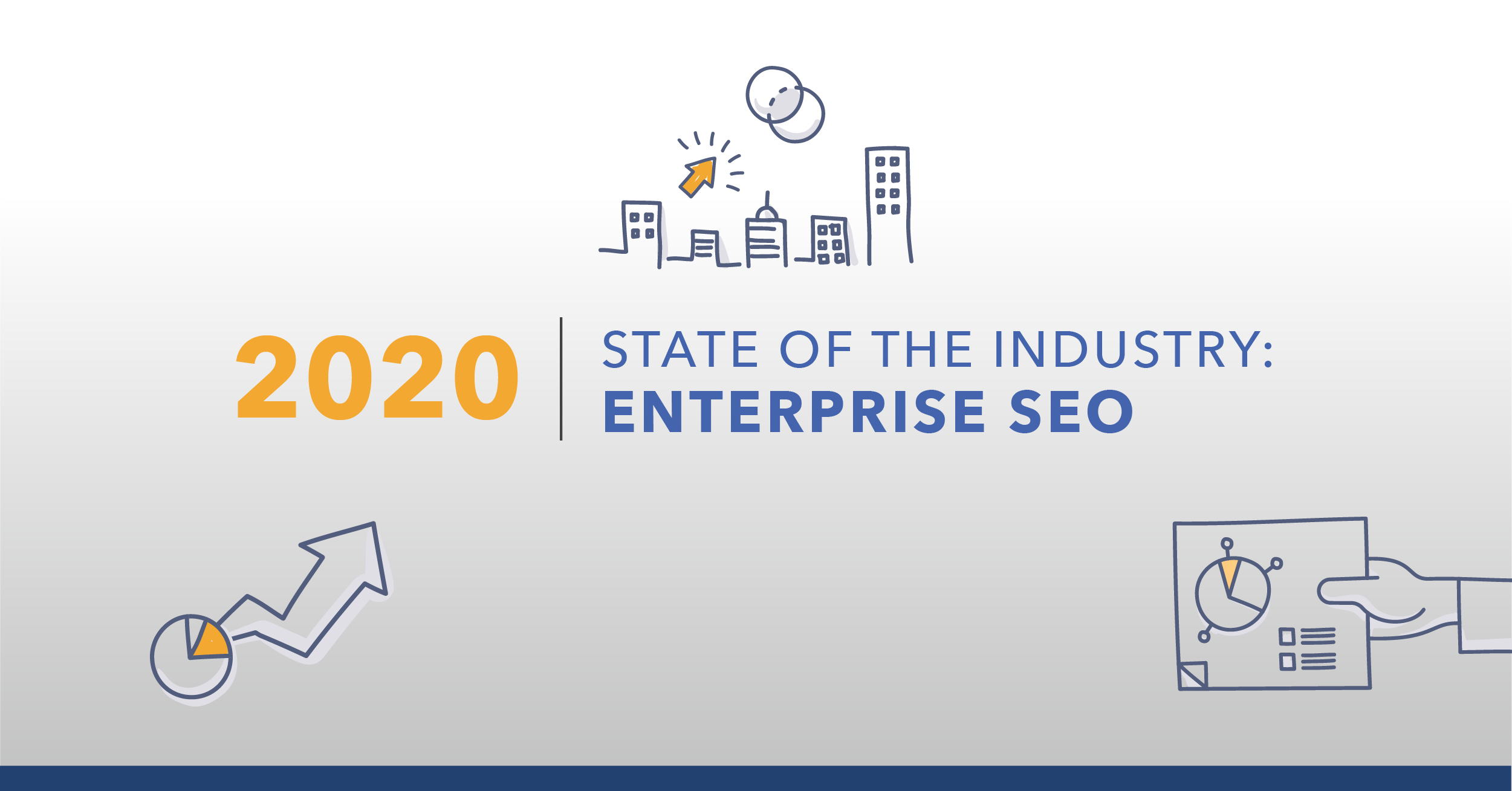
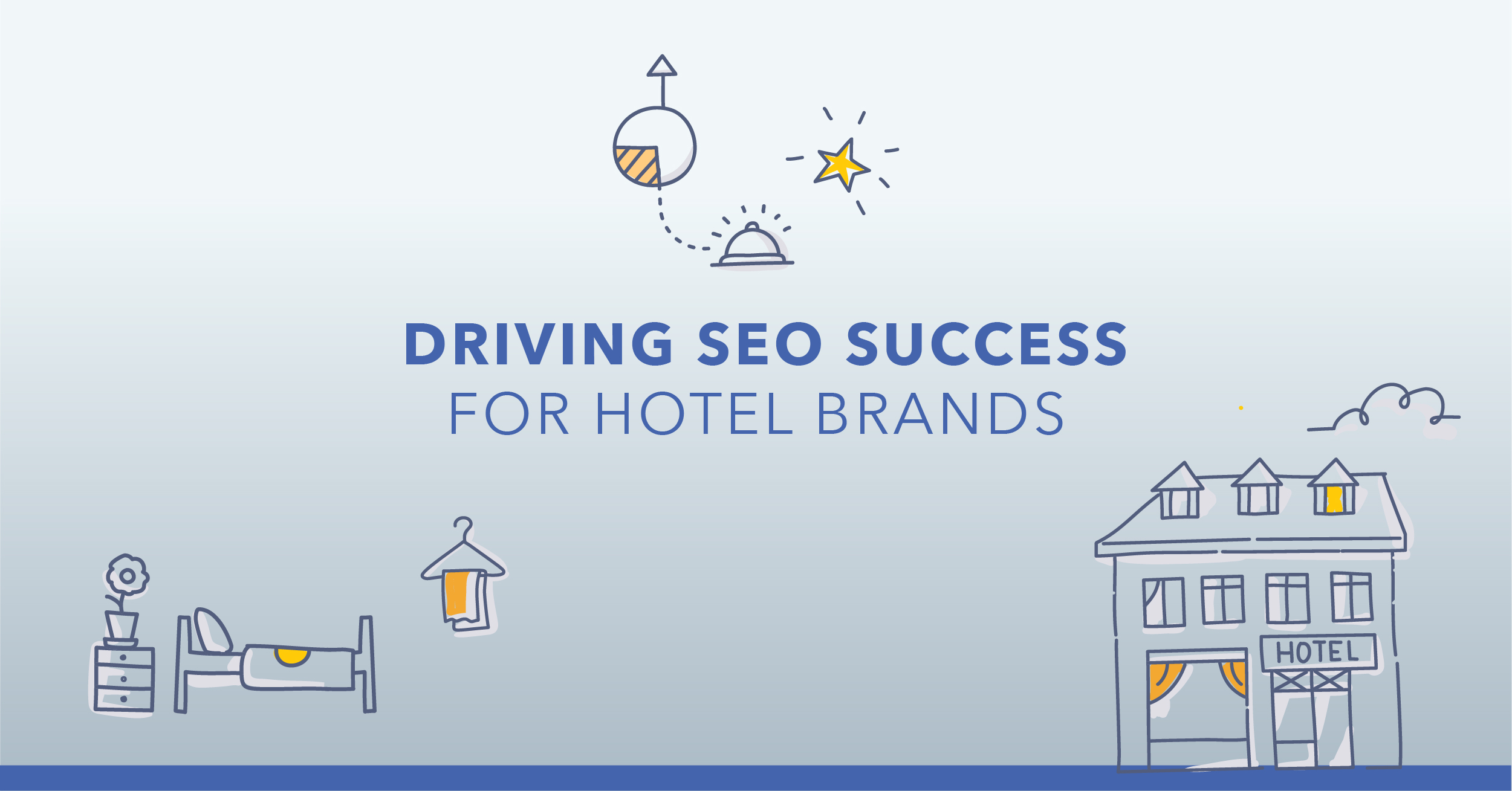

1 Comment
Click here to read/write comments